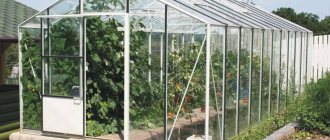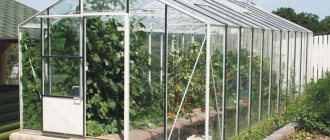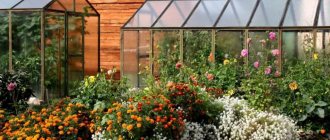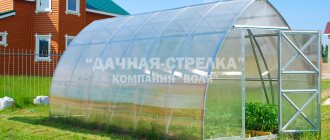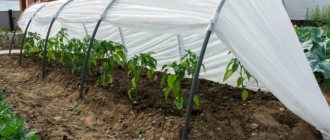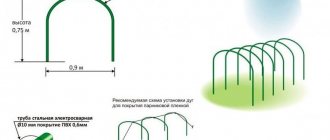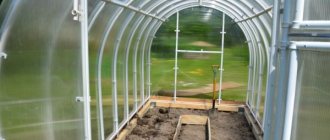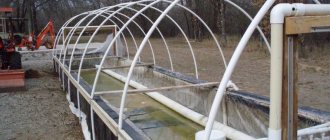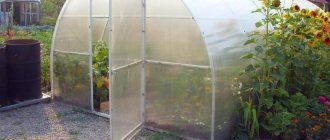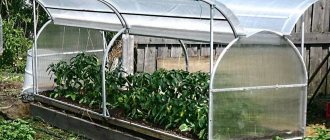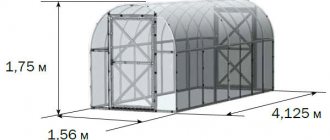Updated: 02/19/2021 18:37:12
Expert: Konstantin Borisovich Polyakov
*Review of the best according to the editors of expertology.ru. About the selection criteria. This material is subjective in nature, does not constitute advertising and does not serve as a purchase guide. Before purchasing, consultation with a specialist is required.
It is possible to obtain a stable harvest of some heat-loving crops in the difficult climatic conditions of Russia only in a greenhouse. Many summer residents and professional vegetable growers have this covering structure. Some people install homemade structures, others find it easier to purchase a finished product with delivery and installation, or you can attach any covering material to a store-bought frame with your own hands. With the help of our experts, we will try to determine the main criteria for choosing a polycarbonate greenhouse for a summer residence.
No. 1. Determining the main tasks of the greenhouse
Surely, everyone who is looking for a greenhouse understands why he needs it and for what purposes it will be used. However, before you begin to understand the advantages and disadvantages of different materials and shapes, it is necessary to very clearly outline the tasks assigned to the greenhouse. For some summer residents, it will be enough for it to look nice and look good on the site. Those who consider the structure as the basis for a business or as a help in the household, although they will pay attention to the appearance of the structure, will not focus on it when choosing a greenhouse.
Typically, greenhouses are built to grow vegetables and berries for their own consumption, but some summer residents plan to make a business out of this in the future. If in the first case the financial investments will not be so significant, then in the second they will become a serious investment, the size of which will largely determine the maintenance costs.
Another question that requires a clear answer is the type of greenhouse model: collapsible or stationary . If you are at your dacha all year round and are not afraid that in your absence someone may damage or even steal the structure (and this happens), it is better to choose a stationary model - it is less hassle. A collapsible greenhouse is an ideal option for those who visit their dacha only in warm weather; it will have to be assembled and disassembled twice a year.
The choice of certain greenhouse parameters also depends on what plants will be grown , because each crop has its own requirements for light and humidity levels. The height of the greenhouse also depends on the characteristics of the plants. For example, for tomatoes and other tall crops it is better to choose a rectangular structure.
No. 2. Where to put the greenhouse?
Choosing a location for a greenhouse is a question no less important than selecting the most suitable design. If the greenhouse is placed incorrectly on the site, the money for its purchase and installation can be considered wasted, as well as the efforts to grow plants. When choosing the optimal location for a greenhouse, it is worth considering the following factors:
- light level – a key parameter when searching for a suitable location. The greenhouse should receive maximum possible amount of light, not be shaded by trees or houses. Otherwise, the cost of artificial lighting will increase, but it will not help grow crops in the expected volume. Experts advise positioning the greenhouse so that one end faces the west and the other faces the east. With this arrangement it is possible to achieve maximum illumination. If plants will be grown in winter, then artificial lighting will not be possible, so it will be necessary to think through the installation of communications in advance;
- winds. The greenhouse must be placed in the calmest and quietest place on the site, protected from winds and drafts, because they will significantly cool the structure, which will lead to serious heating costs in the winter. A nearby house can provide good protection from the winds, but it will cast a shadow, so it is best to protect the greenhouse with a hedge or a low-height blind fence located at a distance (for example, for a greenhouse 2-2.5 m high, the hedge can be placed at a distance 7-7.5 m);
- relief and soil type. The greenhouse must be installed just on level ground, if there is none, then you will have to artificially level the ground. Sandy and swampy soils, like lowlands, are not suitable for placing greenhouses, and clay soil will need to be covered with gravel first, and only then with a layer of fertile soil;
- ease of placement. Many summer residents place greenhouses on the outskirts of their plot. This is justified if, according to all other factors, this is the most suitable place. The farther the greenhouse is located, the less convenient it will be to maintain and the more expensive it will be to connect all communications.
Places where you should not install a greenhouse
User voting
Which greenhouse would you choose or recommend?
Volya Dacha Optima
14.29 % ( 2 )
Bastion Premium
35.71 % ( 5 )
Kremlin Suite
7.14 % ( 1 )
Will Yota
7.14 % ( 1 )
Uralochka
7.14 % ( 1 )
Hacienda-4 Standard
14.29 % ( 2 )
Orange Droplet
7.14 % ( 1 )
Innovator Droplet
7.14 % ( 1 )
Dachna Strelka
0.00 % ( 0 )
No. 3. Greenhouse frame material
The resistance of the greenhouse to all negative environmental factors depends on the frame: winds, the weight of snow, mechanical damage, etc. It is better to spend money once on a more reliable and durable structure than to repair or change it every year. Today, manufacturers offer frames made of wood, plastic and metal . Let's figure out which one is better.
Wooden frame
Wood is the most affordable material for constructing a greenhouse frame, so its popularity in domestic spaces is consistently high, despite its imperfections. Many craftsmen who decide to build a greenhouse with their own hands choose wood, since it is easy to process and has a low weight . include :
- high environmental friendliness;
- corrosion resistance;
- good thermal insulation qualities;
- low cost.
Main disadvantages:
- low strength, in this parameter wood is inferior to plastic and metal;
- ability to absorb moisture and rot;
- the need for constant care to protect against the influence of moisture, mold and pests;
- low durability and the need for constant repairs.
If you do not think through a system for removing water from the greenhouse, the wooden frame will not last long. Such designs remain popular only due to their low cost.
Plastic frame
A PVC frame is one of the most suitable options for greenhouses, but so far it is not often used in our country due to its high cost , which is explained by the complexity of processing the material.
Advantages:
- high aesthetics;
- strength;
- resistance to alkalis, acids, fertilizers and other chemicals;
- resistance to corrosion and rotting;
- low weight and easy DIY installation;
- low thermal conductivity.
Aluminum frame
Aluminum frames are assembled from pipes or profiles, their characteristics are almost identical, and the main advantages are as follows:
- ease;
- rust resistance;
- minimal maintenance and ease of installation.
Minuses:
- high price;
- low thermal insulation.
Steel frame
A steel frame is the best choice today in terms of price and quality ratio. Main advantages : strength, durability, ability to withstand heavy loads, and all this at a fairly low price. The main disadvantages are low thermal insulation properties and susceptibility to corrosion.
The steel frame can be made from:
- pipes;
- profile.
The difference is significant, each material has its own advantages, and the debate over which option is better is reminiscent of arguments about what came first, the chicken or the egg.
The steel pipe frame is the ideal of strength and durability. It is not afraid of snow and wind loads, it will not bend or deform in winter, but you will have to pay for all this: a pipe frame costs much more than a similar one made from a profile. Moreover, it is worth taking into account the large weight of the structure and difficulties in transportation and sometimes installation.
A profile frame is cheaper, easier to install, and it’s not a problem to install it yourself, but it is inferior in strength to its pipe counterpart, so it may require reinforcement.
Steel is susceptible to corrosion, and for protection the frame is galvanized or painted . The second option is cheaper, but requires periodic touch-up to avoid corrosion on the metal and rust spots on the covering material. A galvanized frame will cost a little more, but it is considered a more preferable option, since it will not need additional protection for at least the next 10 years.
To ensure that the metal frame lasts more than one season, pay attention to the following parameters:
- The fewer elements were used to produce the arches and pediments, the better. The ideal is solid-bent arches and welded gables ;
- profile cross-section – 20*40 mm, it is impossible to find more;
- metal thickness – at least 1.2 mm;
- the distance between the arches is at least 0.67 m , otherwise, at the first light snow, the covering material together with the frame will bend.
No. 4. Does a greenhouse need a foundation?
Experienced summer residents prefer to equip the foundation for a future greenhouse. It helps solve a lot of problems:
- maintaining heat and protecting plants from frost;
- protection of the soil and greenhouse from rain streams;
- ensuring reliable fastening of the frame;
- protecting the frame material from destruction.
And if in some cases you can still do without a foundation, then you will definitely have to equip it if:
- the greenhouse is used all year round;
- the frame is made of wood;
- the structure is buried in the soil below its freezing level;
- the greenhouse is large (more than 6 m in length);
- the structure is located on a slope or in a poorly protected place.
Drawings for greenhouses and greenhouses
Self-construction of such a building is not an easy task. Here it is important not only to have construction skills, but also to have a competent design for the future structure. Below are drawings of buildings, the designs of which have been verified by many years of experience in growing plants (Figure 13).
Figure 13. Drawings of popular types of greenhouses
It is also important to choose the right type of polycarbonate for covering and materials for constructing the frame, since the service life of the building will depend on their strength.
No. 5. Which foundation for a greenhouse is better?
Depending on the objectives pursued, choose one of the following foundation options:
- tape , which is organized using concrete, less often sleepers, brick or gravel. Previously, the arrangement of such a foundation was considered mandatory, but is still carried out by many summer residents. The construction is almost permanent; it will be impossible to move it to another place;
- the block foundation is made of reinforced concrete blocks, it is suitable for regions with loose soil;
- pile and point foundations are easy to install and allow you to build a strong, reliable greenhouse;
- timber foundation Recently it has been used more and more often; it can be equipped even by not the greatest professional in the field of construction. The tree will require pre-treatment with antiseptics, but a greenhouse with such a foundation can be easily moved from one place to another - ideal for growing vegetables.
About the disadvantages
Each type of greenhouse has its own advantages and disadvantages. Let's focus on the latter. What are manufacturers keeping silent about or simply choosing not to disclose?
- Arched greenhouse on arcs. It’s good for everyone, it can be installed within an hour, but caring for plants in it will be problematic. No, not on both sides of the aisle - everything is fine here. And in the extreme side rows? At a minimum, you will have to get on all fours to weed or loosen them.
The arched greenhouse model “Dachnaya 2 DUM” is a reliable design for growing vegetables and harvesting a good harvest
Modern reliable model “Rublevsky Summer Resident”
Greenhouse "Kremlevskaya" -3.0*2.0*2.1 m
- Single slope greenhouse. It is excellent and comfortable to work in, but the coating, especially film, is attached with difficulty and with special care. Installation work must be carried out on a dry day without wind. You need to tighten it properly, otherwise the film will simply sag later.
- A polygonal greenhouse is a decoration for a site, an original design attribute, and the most expensive. And at the same time, it is difficult to maintain a constant temperature in it (remember, all edges heat up unevenly, depending on the position of the sun?).
Lean greenhouse
Vegetarian greenhouse 4x12 m lean-to
"Diamonds" of the garden
No. 6. Types of greenhouse coverings
It is easy to notice that the largest area of the greenhouse is occupied by the covering material, so summer residents pay maximum attention to its choice. Currently the following materials are actively used:
- regular and reinforced polyethylene film;
- glass;
- polycarbonate
Each of these materials copes with its direct functions differently.
Glass cover
Previously, glass was almost the only suitable material for arranging a greenhouse. Today everything has changed, but it continues to be used due to the following advantages :
- good light transmittance;
- high thermal insulation characteristics;
- resistance to temperature changes and chemicals;
- durability;
- aesthetics.
Minuses:
- heavy weight, requiring a very good frame;
- fragility. Hail can damage the material, and using laminated or tempered glass is too expensive;
- long and labor-intensive installation process;
- lack of a filter against infrared radiation, which can be harmful to some plants.
Glass is chosen with a thickness of at least 4 mm . The larger the sheets, the higher the light transmission (the area of the frame decreases), but the higher their fragility.
Polyethylene coating
It’s worth taking a look at any dacha cooperative to notice that plastic film is most often used to equip greenhouses.
Advantages:
- good light transmission and the ability to softly diffuse light;
- low price;
- ease of use and low weight;
- protection of plants from light frosts (down to -30C);
- Suitable for greenhouses of any shape.
Flaws:
- rapid wear, especially at fastening points, so the film will have to be changed every year;
- accumulation of condensation film on the surface, which can lead to a number of diseases in plants.
For the low price and ease of use, summer residents forgive polyethylene for its fragility.
If you look at it, the material is presented on the market in several varieties:
- ordinary polyethylene film . Sold in rolls 120-300 cm wide, it requires special care when installing on a frame, since the slightest cut can soon increase significantly. It is better to seal especially dangerous places with tape to guarantee;
- PVC film is more expensive than polyethylene film, but is much stronger, can last 5-7 years, retains heat accumulated during the day well, and blocks infrared rays;
- reinforced polyethylene film can serve for several seasons in a row, as it is equipped with an internal frame made of fiberglass, polypropylene, twisted polyethylene or other materials. Can withstand hail and strong winds.
Polycarbonate cover
The most modern and price- and quality-balanced material for covering greenhouses is cellular polycarbonate. Please note that there is also monolithic polycarbonate on the market, but it is not suitable for greenhouses. Cellular polycarbonate has a special structure: inside it there are partitions (honeycombs) filled with air. This structure provides many advantages:
- high strength, 200 times higher than that of glass. Rain, strong wind and even hail will not harm polycarbonate;
- excellent light transmission and much better heat retention abilities than glass;
- ease of work, since the material bends well, is easy to cut and drill, and is light in weight;
- relative durability (up to 15 years);
- great appearance.
When choosing polycarbonate for a greenhouse, you should pay attention to the thickness : it should be at least 4 mm , and preferably 6 mm; for arranging the roof of a greenhouse, it is better to look for sheets 7-8 mm thick. Without special protection, the material does not withstand sunlight well, so there must be a protective layer - do not believe sellers who talk about using protective additives in bulk, this is all short-lived material. When heated, polycarbonate tends to expand, so experienced specialists recommend installation at a temperature of at least +100C and fastening the sheets overlapping.
Other materials for covering greenhouses
The following materials can also be used to cover the greenhouse:
- spunbond – non-woven material obtained from a polymer melt with the addition of stabilizers for resistance to ultraviolet rays. This is a dense white fabric, often called agrofibre. It has good strength, light transmission, high thermal insulation properties, is resistant to rotting, temperature changes and chemicals, and will last up to 5 seasons;
- plexiglass is a durable material, suitable for northern snowy regions. The downside is the high price;
- Fiberglass is made from polyester resins, reinforced with reinforcement, and retains heat well.
Glass or polycarbonate
The next stage in the construction of a greenhouse is the choice of material for the covering. The leading three today include polycarbonate, film, and glass.
The cheapest solution is film; it makes it easy to dismantle the roof or part of the wall to ensure ventilation.
The material is easy to install; you can use it to cover a greenhouse yourself. in the fall it is removed for storage, so the film does not have to withstand strong gusts of wind or the weight of snow. True, with the onset of the new season, the greenhouse has to be closed again. This solution is suitable for summer residents who leave their estate during the cold season and cannot care for outbuildings.
After removing the film, the ground of the greenhouse is covered with snow, which provides favorable conditions for the proliferation of microorganisms. When a greenhouse remains under a roof, the ground freezes and beneficial bacteria die. Therefore, it is important to throw snow or manure into the greenhouse in winter.
Film is the cheapest material, but it wears out quickly, so you have to buy a new one every season. Many types of polyethylene lose their transparency over the summer and wear out under the influence of wind and ultraviolet radiation. In addition, the material can be easily torn or accidentally punctured. However, it will not break, which ensures the safety of people, unlike glass.
Some summer residents use reinforced films, which last longer and are resistant to stretching, due to the presence of a mesh frame inside. Such a film can easily withstand hail and strong winds and can last for several seasons.
Pros and cons of glass greenhouses
Glass has a high light transmittance. A greenhouse covered with such material will provide the summer resident with the following advantages:
- Completely inert with respect to combustion and oxidation, which film polymers cannot boast of. Such a greenhouse can be safely heated in cold weather without fear of fire or release of toxins.
- By combining a glass covering with a wooden frame, the summer resident receives an environmentally friendly structure.
- In warm weather, a static microclimate is created in a glass greenhouse.
- Caring for glass is also easy. It is enough to wash it periodically using mild cleansers.
Among the disadvantages of glass, it is worth noting the high weight of the material, fragility, which poses a danger, and high thermal conductivity. Using glass, you can build a single or gable greenhouse; you will definitely need a foundation. Installation and disassembly of glass structures must be done very carefully.
It is logical that a glass greenhouse will last much longer than a film greenhouse. However, the high thermal conductivity of the material will not allow obtaining a sufficiently high temperature inside the structure without additional heating. Therefore, the harvest there will be quite late.
Polycarbonate greenhouses
A relatively new material is polymer sheets that are resistant to mechanical damage. Polycarbonate has no less transmission capacity than glass, but does not release heat to the outside. When installing, it is important to position the sheets correctly; you must not confuse the front side with the back. The underside of polycarbonate is quickly destroyed by sunlight.
Thanks to the properties of polycarbonate, the greenhouse retains heat well, but in warm sunny weather the temperature in it can reach 50°. Therefore, when installing a greenhouse, it is important to immediately make two doors and two vents for ventilation. Like any material, polycarbonate is not without its drawbacks. It cannot be cleaned with abrasive detergents or wiped with solvents. To build a greenhouse you will need a solid foundation. The material can only be stored horizontally. In addition, polycarbonate is quite expensive.
No. 7. Greenhouse shape
To ensure a good harvest, it is not enough to choose a suitable frame and covering material; you also need to find the optimal shape. The most common options:
- arched greenhouses , as well as domed and teardrop-shaped ones, retain heat well, are easy to arrange, do not contain sharp corners, therefore they require much less covering material, and precipitation does not linger on them. Such structures can be transformed, but they are limited in the choice of coating - mainly polycarbonate is used. In addition, access to the outer beds will be difficult;
- greenhouses with a gable roof will require more material for arrangement, but the area for planting in them is significantly larger. The design provides excellent lighting even under cloudy skies, withstands snow loads well, but is more expensive than the arched one;
- lean-to greenhouses are often installed near the wall of the house, which allows for significant savings. It is better to direct the roof slope to the south side;
- A pyramid greenhouse is an option for those who love everything unusual. The designs are complex in execution and are in demand among gardeners;
- polygonal greenhouse - an impressive and expensive structure, but due to the presence of a large number of sides, the structure warms up well at any time of the day.
Main factors and aspects of choice
Before choosing a greenhouse for your dacha, you need to clearly define the parameters that you need to navigate during the purchase:
- design configuration - most often preference is given to single- and double-slope, Dutch and arched;
- parameters – height and width are some of the important criteria;
- frame, as well as covering material of the structure;
- way of organizing the internal space: more functional and practical options will be with shelves, racks and fairly wide internal passages.
In this case, much attention should be paid to the area, as well as to the features of the layout of the personal plot on which the structure will be located. In addition, it is worth considering the types of crops that will be grown according to the plan.
Recently, the so-called Dutch greenhouses have become quite popular, attracting with their increased stability and ability to retain warm air inside well. Their characteristic difference is that the walls are installed at a slight slope - very good illumination is provided not only in the upper part of the structure, but also at its base. This allows greenhouses to be used for growing low-growing crops.
Dutch greenhouse Source tunnelvisionhoops.com
No less practical are lean-to structures, which are more affordable. They are the most suitable option for installation in areas with a small area. And for very small areas it is recommended to choose polygonal greenhouses with a multi-pitched roof.
Greenhouse project with a pitched roof Source finderskeepers.info
No. 8. Greenhouse dimensions
Everyone decides for themselves whether to purchase a ready-made greenhouse or build it themselves, what type and size it should be, but when choosing, take into account some useful recommendations. The optimal width of the greenhouse is 3-3.5 m ; if it is narrower, then the required number of beds will not fit, and you will have to save on aisles. The length can be any, a common option is 4-6 m. It is not recommended to make a greenhouse longer than 6 m - it will be more difficult to care for the plants. It is better to make two greenhouses 6 m each than one 10-12 m. The optimal height to the ridge is 2.5 m, the height of the low wall is 1.5 m. The doors should be wide enough (about 1 m) so that you can easily was to stop by the greenhouse with a garden cart.
Video description
Those for whom aesthetics are important should also think about the design of the structure.
You can see a selection of inspiring greenhouses in this video: When choosing a covering, experts recommend taking into account the climatic conditions of the region, the crops that will be grown, and individual preferences. You need to weigh the pros and cons, take into account the available footage and set the budget to choose the best option. By contacting us for a consultation, you will receive answers to all your questions.
A designer greenhouse will be an excellent decoration for the site. Source houzz.com
No. 9. Attention to the package
If you, like many summer residents, have opted for a ready-made greenhouse , then when purchasing, pay attention to what is included in the kit. In addition to the frame and covering material, there must also be seals, as well as doors and vents. The location of the latter is of great importance: in the summer heat, without normal ventilation, the plants in the greenhouse will burn, so ideally the doors should be on both sides, and the presence of windows is also necessary. The prefix “economy” in the name of the greenhouse model means that the greenhouse can only be used in warm weather or its design can be significantly modified, since often the step between the arcs is too large. A responsible manufacturer will always provide the design with assembly instructions.
No. 10. The best greenhouse manufacturers
The secret to choosing a high-quality greenhouse is simple: do not buy at too low prices (often these are Chinese-made products of very low quality) and trust large manufacturers, and it is advisable to contact a company store or the company’s website, and not an intermediary. Little-known fly-by-night companies are not the best option - they may close soon, you won’t be able to file a claim against them, and you won’t be able to buy a new greenhouse with the couple of thousand rubles you saved.
Among those presented on the domestic market, the products of such companies perform best:
- Volya is the largest domestic enterprise in the sector, operating since 1993, producing polycarbonate greenhouses, film greenhouses, various materials and accessories for greenhouses, as well as industrial greenhouses and a number of related products and irrigation systems;
- produces only polycarbonate greenhouses. The frame is distinguished by a reliable zinc coating, firmly welded, polycarbonate is represented by products from different manufacturers. Product warranty 7 years;
- “Factory of ready-made greenhouses” has its own production of polycarbonate with a thickness of 4 to 16 mm and steel square pipe. Warehouses are located in all regions of the country;
- “People's Greenhouse Plant” independently produces a metal square pipe for constructing a frame; ready-made greenhouses are completed with domestically produced polycarbonate 4-10 mm thick with a protective coating. The range also includes a number of related products;
- "Rus-Teplitsa" offers easy-to-install greenhouses made of painted and galvanized pipes coated with polycarbonate;
- "Greenhouses of the North" . The company has been operating since 2010, producing frames made of galvanized profiles coated with polycarbonate in various shapes and sizes.
The selection of ready-made greenhouses is impressive, and gardeners with “hands on” can try to build a greenhouse themselves. Be that as it may, when choosing and constructing a greenhouse, take into account the nuances described above.
The article was written for the site.
Tags:Greenhouse
